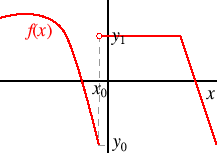1.3 Intervals and functions
Intervals
An interval is a set of (real) numbers between, and possibly including, two numbers. The interval from a to b is denoted as follows:- [a, b] if a and b are included (i.e. [a, b] = {x: a ≤ x ≤ b})
- (a, b) if neither a nor b is included (i.e. (a, b) = {x: a < x < b})
- [a, b) if a is included but b is not
- (a, b] if b is included but a is not.
- (a, ∞) is the interval {x: a < x}.
- (−∞, a] is the interval {x: x ≤ a}.
- (−∞, ∞) is the set of all numbers.
The notation (a, b) is used also for an ordered pair of numbers. The fact that the notation has two meanings is unfortunate, but the intended meaning is usually clear from the context. (If it is not, complain to the author.)
The interior of an interval is the set of all numbers in the interval except the endpoints. Thus the interior of [a, b] is (a, b); the interval (a, b) is the interior also of the intervals (a, b], [a, b), and (a, b).
We say that (a, b), which does not contain its endpoints, is an open interval, whereas [a, b], which does contain its endpoints, is a closed interval. The intervals (a, b] and [a, b) are neither open nor closed.
Functions
A function is a rule that associates with every member of some set, a single member of another set. The first set is called the domain of the function. A function with domain A is said to be defined on A.
To specify a function we need to specify the domain and the rule. Here are some examples.
- Domain: [−2, 1]. Rule: f (x) = x2.
- Domain: (−∞, ∞). Rule: f (x) = x2.
- Domain: (−1, 1). Rule: f (x) = x if x ≥ 0; f (x) = 1/x if x < 0.
- Domain: union of (0, 1) and (4, 6). Rule: f (x) = √x.
- Domain: set of all pairs of numbers. Rule: f (x, y) = xy.
- Domain: set of n-vectors (x1, ..., xn) for which 0 ≤ xi ≤ 1 for i = 1, ..., n. Rule: f (x1, ..., xn) = ∑i=1naixi, where a1, ..., an are nonnegative constants.
These examples have two features in common:
- the domain is a subset of the set of n-vectors of numbers, for some positive integer n (where n may of course be 1, as in the first four examples)
- the rule associates a real number with each point in the domain.
The number that a function associates with a given member x of its domain is called the value of the function at x. As x varies over all points in the domain of a function, the value of the function may (and generally does) vary. The set of all such values of the function is called the range of the function. Here are the ranges of the examples given above.
- Domain: [−2, 1]. Rule: f (x) = x2. Range: [0, 4].
- Domain: (−∞, ∞). Rule: f (x) = x2. Range: [0, ∞).
- Domain: (−1, 1). Rule: f (x) = x if x ≥ 0; f (x) = 1/x if x < 0. Range: union of (−∞, −1) and [0, 1).
- Domain: union of (0, 1) and (4, 6). Rule: f (x) = √x. Range: union of (0, 1) and (2, √6).
- Domain: set of all pairs of numbers. Rule: f (x, y) = xy. Range: (−∞, ∞).
- Domain: set of n-vectors (x1, ..., xn) for which 0 ≤ xi ≤ 1 for i = 1, ..., n. Rule: f (x1, ..., xn) = ∑i=1naixi, where a1, ..., an are nonnegative constants. Range: (0, ∑i=1nai).
Graphical illustrations aid the understanding of many functions. A function of a single variable, for example, may be represented on x−y coordinates by plotting, for each value of x, the value of f (x) on the y-axis. An example is shown in the following figure. In this diagram, the small circle indicates a point excluded from the graph: the value of the function at x0 is y0, whereas the value of the function at points slightly greater than x0 is y1.

The red line in this figure is called the graph of the function. Techniques for drawing graphs are discussed in a later section.
Logarithms and exponentials
You need to be comfortable working with the logarithm function and with functions of the form xy (where y is known as an exponent). In particular, you should know the following rules.- xyxz = xy+z
- (xy)z = xyz (so that in particular (xy)1/y = x)
- ln ex = x and eln x = x
- a ln x = ln xa (so that ea ln x = xa)
Continuous functions
A function of a single variable is continuous if its graph has no "jumps", so that it can be drawn without lifting pen from paper. In more precise terms, a function f is continuous at the point a if we can ensure that the value f (x) of the function is as close as we wish to f (a) by choosing x close enough to a. Here is a completely precise definition for a function of many variables. (The distance between two points (x1, ..., xn) and (y1, ..., yn) is the Euclidean distance √[∑i=1n(xi − yi)2].)
|
|
|


No comments:
Post a Comment